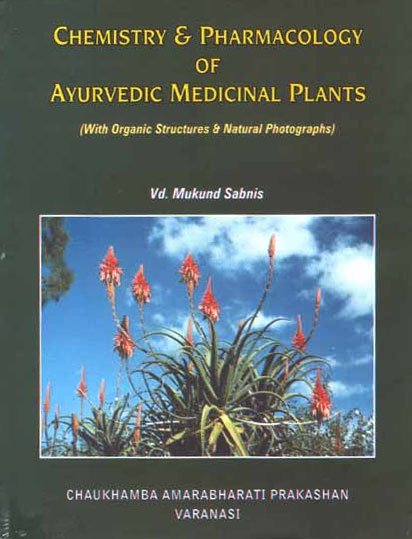Chemistry and Pharmacology of Ayurvedic Medicinal Plants
author: Mukund Sabnis
edition: 2006, Chaukhambha Amarbharati Prakashan
pages: 501
Topic: Ayurveda
Introduction
Ayurveda is an ancient science of life practiced with an aim of preservation and promotion of health and alleviation of disease. In true sense it is an eternal science. The history of medicine can be traced back to existence of humans who since antiquity used to live in groups and societies in different areas of the world. Man suffered from different health problems and he tried to use various methods to get rid of these problems. Methods used to treat the illness led to form a system of medicine. Thus these ancient civilizations developed their own medicinal system along with their specific philosophies. The modern medicine, which is widely accepted today has its roots embedded in traditional medicine. Every country has its own traditional system of medicine, which helps to fulfill the needs of people living in that area.
There is a great difference between the medicinal system and therapy. A medicinal system explains the cause, diagnosis, prognosis, prevention and cure for the disease and also has its own principle on which the complete system is elaborated. Therapy has a limited meaning, which is restricted only with the treatment. Ayurveda is not a therapy or therapeutic science with a bunch of therapies but it is a science of life dealing with all aspects of life. It is so deeply rooted in Indian culture that it has become a way of life in the Indian subcontinent. WHO has defined traditional medicine as "the sum total of all knowledge and practices, whether explicable or not, used in diagnosis, prevention and elimination of physical, mental or social imbalance and relaying exclusively on practical experience and observation handed down from generation to generation, verbally or in writing".
Ayurveda is a system of medicine, which has a great tradition having its roots in Vedas. Knowledge of Ayurveda is scattered in Samhitas the age old books, which are named after their authors, are compendia of the Ayurvedic literature described in a very systemic manner.
The samhitas are written in Sanskrit, which was the language in those days. Majority of the part of these samhitas is written in poetic form, which became easy to memorise. As in those days the knowledge was given from the teacher to student by word of mouth, the poetic form of the Samhitas was maintained.
History of Ayurveda can be devided into three periods.
- The pre Vedic period.
- The Vedic period.
- The Arsha period.
The pre Vedic period is said to be around 6000 B.C. It is the period before the origin of Vedas. In this period many sciences were in developmental stage. Ayurveda a system of medicine might have got its initial literal form in this period. As per some of the scholars this system of medicine is originated from Lord Brahma who gave this science to Lord Indra through Dakshaprajapati and Ashwini kumar.
Prevedic period is followed by Vedic period. This period is said to a time in which the four Vedas namely Rigveda, Yajurveda, Samaveda and Atharvaveda were written. The Vedic period falls between 6000 B. C. to 200 B. C. Much of the quotations of Ayurvedic system of medicines are found in Athavaveda. Number of diseases and its cures are described in Atharvaveda, though it does not quote any basic fundamentals about this system of medicine. Atharvaveda describes important organs of the body. It seems that the medical professionals knew the concept of Agni in those time. Cow's product like butter, buttermilk, curds, milk, cow dung and Cow's urine are used for medicinal purpose. Honey and ghee are also described. Five types of Vayus Prana, Udan Apana, Vyana and Samana are mentioned in Atharvaveda. Disease like Kasa, Yaksma, Jalodara, and Kilasa are explained. Medicinal herbs like Guggul Kustha, and Shatavari are mentioned. It has been explained in Atharvaveda that water and wind produce disease. It can be said that the Vataj, Pittaj and Kaphaj classification of diseases is a seedling of classification latter established by Ayurveda. Because of this background Ayurveda is called as Upanga or branch of Atharvaveda. The Vedic period is followed by Arsha period. This is an important period for the development of Ayurveda, as much of the fundamentals of this ancient science were laid down in this period. During this era two different schools of thoughts, which are called as 'sampradaya', were developed. The first one is 'Atreya sampradaya' and the second one is 'Dhanwantari sampradaya'. This period is around 1000 B. C. Atreya developed the school of medicine and his disciples were Agnivesha, Bhela, Jatukarna, Parashar, Harita, and Ksharapani. All of these disciples wrote their own Samhitas however Agnivesha Samhita was well accepted. Further this Samhita was revised by Charaka and was named after his name, which is available today as Charaka Samhita.
Aupadhenava, Vaitarna, Aurabhra, Pnshkalavat, Gopurrakshita and Sushrut were disciples ofDhanvantari who developed his own school of surgeons i.e Dhanvantari sampradaya, Sushrut wrote his compendia, which is available today as Sushrut Samhita. These two Samhitas Charak Samhita and Sushrut Samhita are considered as the base of Ayurvedic system of medicine. All the basic principles i.e. siddhantas of this system of medicine are well elaborated in these two Samhitas.
